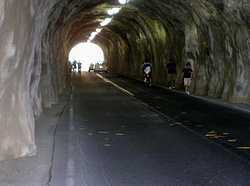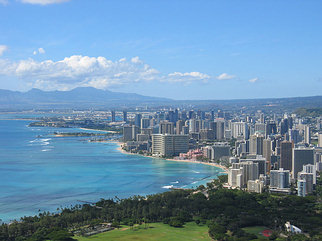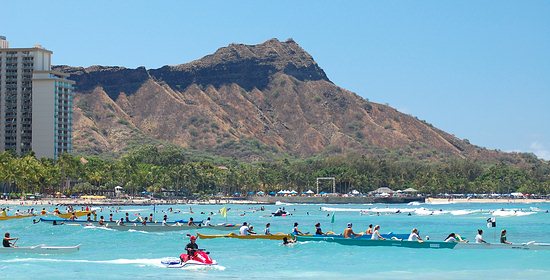Diamond Head Volcano State Landmark, Honolulu, Island of Oahu, Hawaii
Also spelled Diamondhead (disambiguation)
Location: From Waikiki follow Diamond Head Road nestled between Makapu’u Ave. and 18th Ave. Detailed directions at bottom of this article.
GPS Coordinates for Geo Cachers: 21°15’35.0 N 157°48’42.3 W / 21.25972°N 157.81175°W / 21.25972; -157.81175
WHAT IS DIAMOND HEAD VOLCANO ABOUT?
Diamond Head is a volcanic cone with highest vertical height reaching 762 feet (232.3 meters) into the Honolulu sky. The crater is 3,520 feet in diameter, encompassing 350 acres of space. Diamond head is located in the Hawaiian Islands on the island of Oahu near Waikiki, and overlooking the Pacific Ocean. It is part of the Hawaiian Islands Volcanic range, which is the result of a violent explosion about 300,000 years ago which was also responsible for numerous famous Oahu landmarks like Punchbowl crater, Koko Head (which can also be explored on foot), Manana Island (near Makapu’u), and Hanauma Bay snorkeling paradise.
The origin of the English name, “Diamond head” came from 19th century British sailors who thought the sparkling, clear calcite crystals were diamonds. Hawaiians had named the volcano “L’ahi”, literally meaning “brow of the tuna” (tuna fish, ‘ahi’ in Hawaiian language) which some say the cone looks like when viewed from Waikiki. Diamond Head park is owned by the State of Hawaii and governed by the Department of Land and Natural Resources, Division of State Parks, State of Hawaii centered in Honolulu.
MY FIRST TRIP TO DIAMOND HEAD VOLCANO

Diamond Head Tunnel by Alan Levine is licensed under CC0 1.0. Image may have been resized or cropped from original
Christmas day, 1985 some friends of mine and I headed to Diamond Head to climb this extinct volcano. We parked outside the vent and walked on a road that led through one of the volcanic walls. The inside is vast – like a big round, flat baseball stadium or pavilion. It’s an odd feeling the first time you’re standing in the center of a volcano. The explosion that created the 700 foot high rim must have shook all the Hawaiian islands.
We bought some bottled water at the bottom of the Diamond Head trail and started the slow ascent to the top. There is a paved sidewalk for some of the journey, volcanic dirt path and concrete steps for other sections. The path is not too steep and I saw people of all ages and sizes. Go slowly and you can make it to the top like everyone else eventually does. There are 76 steps first, then 99 steps and a 200+ feet tunnel that change up the climb and give you some variety. At the top is a tight staircase that spirals up inside the military observation platform (bunker) built in 1908.
There is a platform at the top of the volcano that is actually over top a military bunker for the World War II conflict. No artillery was ever fired from Diamond Head, but you’d never know that by looking at it.
The views from the top of the volcano are as gorgeous as any I’ve seen around the world – world class, and maybe the ultimate view I’ve ever seen. The water of Waikiki is crystal blue, the greens of Kapiolani park, stunning. Diamond Head can be seen from as far as Eva Beach, Pearl Harbor, and Hawaii Kai, as well as almost anywhere on the southwest side of the Ko’olau mountains. The adventurous can walk around the rim of the volcano for a short while to see other spots, and be afforded different views.

Blue Pacific Ocean and downtown Waikiki highrise buildings with the green grass of Kapiolani park. Copyright skyseeker at Flickr.com Creative Commons.
Where have you ever stayed in these Waikiki hotels? by skyseeker is licensed under CC BY 2.0. Image may have been resized or cropped from original
The Diamond Head attraction is an absolute must-see on your vacation, no matter how old you are, how heavy you are, how unmotivated you are. Once you arrive at the base of the climb the motivation will hit you and you’ll make yourself get up to the top like the kids and grandparents that are coming the opposite way, having already conquered this amazing place.
WHAT CAN YOU DO AT DIAMOND HEAD VOLCANO NATIONAL PARK?
Climb it! The name of the trail is, “Diamond Head Summit Trail” and it winds almost a mile up the inside wall of the volcano.
Surf! At the base of Diamond Head is some of the most consistent surfing to be found in the Hawaiian islands. Groms (beginners) to experts regularly surf the area – a couple hundred yards in width. Surf is typically 2-3 feet high with regular sets coming almost every day of the year. Caution is advised, as the waves are breaking over shallow coral reef.
ESSENTIALS
- Diamond Head is hot and dry, and receives less than 25 inches per year in annual precipitation
- Flora: Ilima (Sida fallax) – an abundant native plant with yellow-orange flowers that is seen often within Diamond Head crater
- Kiawe (Algoroba) – from South America, this tree is common in the leeward areas of the major Hawaiian islands. Close in nature to “mesquite”. It is grown for cattle feed and charcoal.
- Koa Haole (Leucaena) – Similar to kiawe it’s a small tree that adapted to the crater’s dry, lowland. The name when translated means “foreign koa”.
- Lions Ear (Leonotis) – originally from tropical Africa this is an annual plant introduced to Hawaii in early 20th century. It has distinctive prickly flower clusters that vary in color from green to brown depending on how dry they are.
GEOLOGIC CONDITIONS AND HISTORY
The Honolulu Volcanic Series created a number of volcanic vents, volcanic cones and flows on and around Oahu – of which Diamond Head is part of. This series created two of the best known landmarks of Hawaii – Diamond Head Volcano and Hanauma Bay.
Diamond Head Volcano, at 150,000 years old isn’t near as old as the Ko’olau mountain range that divides the mauka and leeward sides of the islands – at 2.6 million years old.
The massive eruption that blew through the bottom of the sea floor, coral reef, and long-hardened volcanic earth that created Diamond Head was likely very quick, lasting a couple of days. The Diamond Head cone is very symmetrical, leading scientists to conclude that it was a very fast eruption and quick cooling off.
Volcanic scientists don’t believe Diamond Head will erupt again because the type of eruption that created it tends to be monogenetic, not likely to repeat the same way.
Ancient Hawaiians, arriving to Hawaii between 1,000 and 1,500 years ago used the peak of the Diamond Head lava cone to build fires to help boats navigate the reef below. There were reportedly Heiaus – Hawaiian religious shrines, temples, as well.
In late 1700 foreigners had made it to Diamond Head and climbed it’s interior to the peak. Curiously they found no evidence of Hawaiians having been there. In Hawaiian culture the volcanoes were there home of Pele – and so, kapu. Kapu means forbidden and no Hawaiian would ever consider going there to the crater. The Heiau were build along the walls of the volcano.
Hawaii was annexed by the United States in 1898. Perimeter defense of the country was of prime importance so the military assigned Fort Ruger, Hawaii’s 1st military reservation inside Diamond Head crater. An entire battery of gunpowder canons was placed in the well protected fort – which have since been removed. In 1903 the US government purchased the crater for its military facilities. The sacred Hawaiian Heiau were destroyed and the sacred rocks used for rock needed for military projects. Hawaii became the 50th US State in 1959 fueling an increasing tourist count. Around 1975 some parts of the crater were sectioned off for public use. The official Diamond Head State Monument was established in 1962. It was made a National US Natural Landmark in 1968. Large Woodstock-like concerts were held in the crater from 1968. The state park inside the walls of the cone was officially opened for public recreational use in 1976.
Today there is also an operational Federal Aviation Administration (FAA) facility inside the crater as well as various facilities for Hawaii Civil Defense, Honolulu Emergency Services and the US National Guard.
The US military still maintains antennas and other equipment at Diamond Head in an off-limits area. An observation deck was constructed at the summit in 1910 to provide target sighting and a four level underground complex was built within the walls of the crater as a command post. A 580-foot tunnel was dug through the crater wall to provide easier access to the Fort.
From 1979 to 1999 the amount of visitors to Diamond Head increased from 41,000 to 800,000. Today Diamond Head Volcano National Park receives over 1 million visitors per year, and over 2,000 per day climb the interior trail leading to the volcano’s rim.
COMMERCIALIZATION
Diamond Head is the most recognizable landmark of Hawaii – worldwide. You’ll find the volcano’s images on logos, shirts, shoes, sheets, pillows, vans, tour agencies windows, literally everywhere in Hawaii. In 1975 there was a Diamond Head game show on television hosted by Bob Eubanks. Contestants that got to the finals were able to climb into a clear “money volcano” to try their skill at catching flying paper money propelled into the air by fans.
Diamond Head Park Entrance Fee:
As of 2016 visitors pay $5.00 per car or $1 per person for pedestrians – including those dropped off by taxi or other vehicle. Commercial vehicles fees: $10.00 cars/vans, $20 mini-buses, $40 buses.
When Can I Visit Diamond Head Volcano?
Hours: Daily 6:00 a.m. to 6:00p.m., Every day of the year including holidays
Trip Duration:
Most people can climb to the top within 1.5 – 2 hours the sign at the bottom say. I think most people get up in 1 hour. The climb requires some exertion. There are cautions for those with heart problems because in the heat it can be a strenuous climb for some.
WHAT SHOULD YOU BRING?
- bottled water – 1-2 liters or quarts per person should be enough
- small flashlight – nobody else has them, but your trip through the tunnel will be safer with one
- wear Teva-type sport sandals with multiple straps so you don’t slip out of your shoes, or athletic shoes. Hawaiian ‘slippahs” (flip-flops) are not recommended.
- sunscreen
- wide brimmed hat
- loose long sleeved shirt if you don’t want burned
- camera – and video recorder
DIAMOND HEAD TIPS
- Arrive just before 6 am. to beat the hundreds of other visitors that will be arriving by tour bus shortly after. The climb is cooler at this time too – you’ll appreciate it!
- Staff reports that 70% of visitors come between 9 am and 1 pm. Avoid these hours for the best experience!
- The winds are blocked by the crater walls so even though it might be windy at the beach, it will be hot inside the crater where the dark volcanic rock holds the heat and the walls block much of the wind. Be prepared, there are many helicopter rescues for tourists that have heat exhaustion.
- At about 4:30 pm. each day the staff won’t let you start the hike because you won’t get up and down in time before the park closes at 6 pm.
- Sunrise varies between 5:49 am. and 7:12 am. Sunset varies between 5:48 pm. to 7:18 pm.
- No shade, so go early or late afternoon to avoid the sun as much as possible
- Bathrooms, water, souvenirs available before you climb. No restroom or water at peak.
- No smoking on the trail.
- No strollers allowed.
- No pets.
- No climbing the lava walls off the trail.
- If you are fit you can make it to the top in under 30 minutes.
- Occasional closures of the park for maintenance – see this page first for latest info.
- The visitor information stand has artistic wall exhibits, beverages in vending machines, a lunch wagon selling food and beverages, and informative signs. The prices are high – if you’re cost conscious, bring your own drinks and snacks.
- But, you should buy the Hawaiian Shave Ice after you’re finished with the hike.
- Use the wire cage for recycling plastic and aluminum – the money collected from recycling goes to local Hawaiian schools.
- Theft is sometimes a problem, even with the guard gate. Lock your vehicles or, take all valuables with you.
Official Brochure:
Diamond Head Park Brochure – they removed from online
DIAMOND HEAD NATIONAL PARK REVIEWS
208 reviewers of Diamond Head Volcano on review site, Yelp.com, gave it an average 4.5 out of 5 rating. Those that rated less than a full 5 stars mostly had issues with the crowd, so they went at the wrong time. Go before 7 am. for the best experience.
DIRECTIONS
By car from Waikiki go east along Kalakaua to the intersection with Monsarrat Avenue at the Honolulu Zoo corner. Turn left onto Monsarrat and proceed 1 ¼ miles until the road becomes Diamond Head Road. Follow this road for ¼ mile to the access road to the crater. Go through the tunnel into the interior of the crater and proceed to the designated parking area.
By bus – take TheBus (#58) from Waikiki. Tell the bus driver you’d like to get off at Diamond Head.
View Map
Bottom Line: Diamond Head Volcano is a world-class attraction that won’t disappoint you. It is fun for the entire family and you will be very happy you planned a trip here to see it.



What do you think?